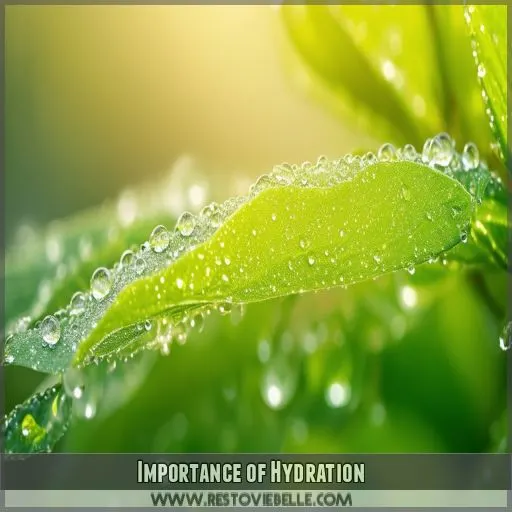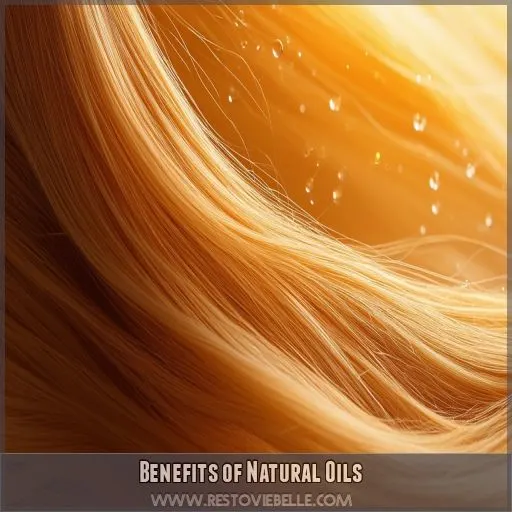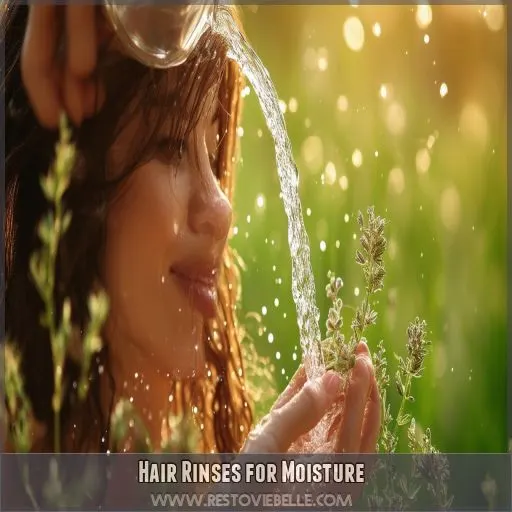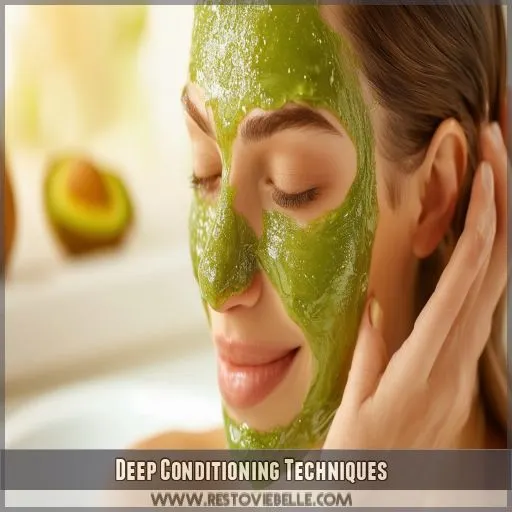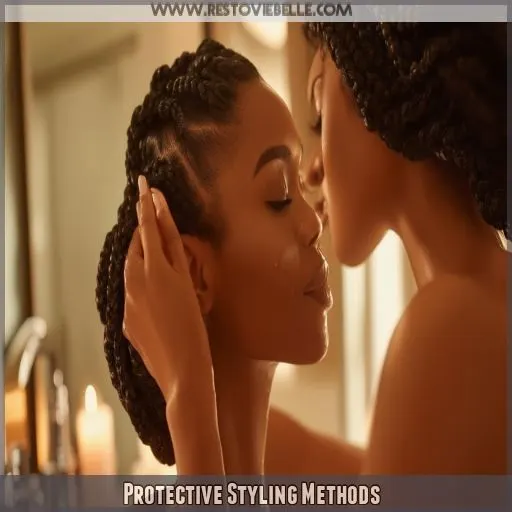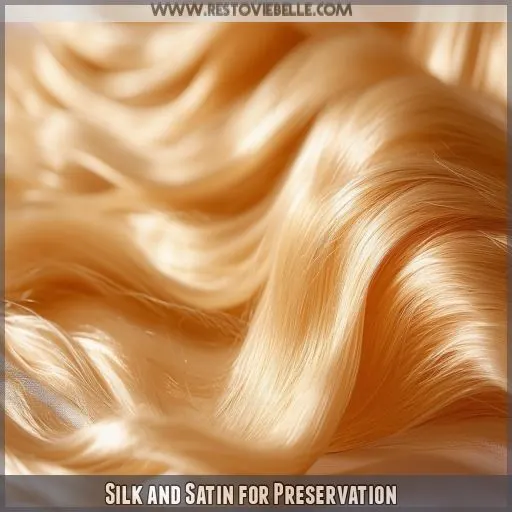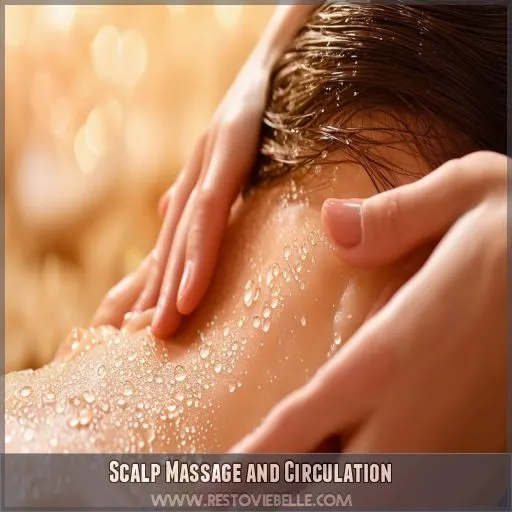This site is supported by our readers. We may earn a commission, at no cost to you, if you purchase through links.
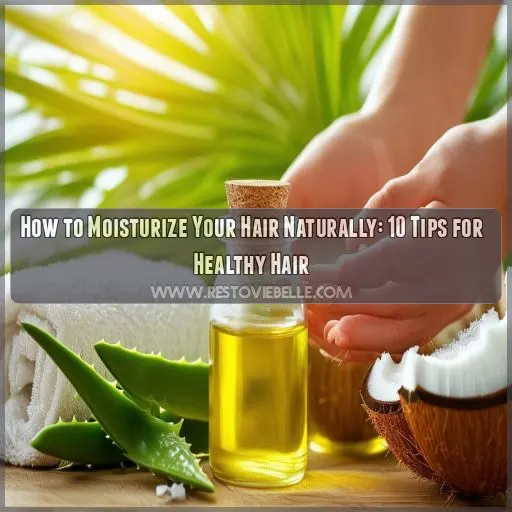 Thirsty hair craves hydration.
Thirsty hair craves hydration.
Yet, finding the right natural moisturizing routine can feel like a desert trek.
Venture on a journey to quench your hair’s thirst with our 10 expert tips.
From nourishing oils to scalp massages, uncover how to moisturize your hair naturally for lasting softness, shine, and strength.
Discover the secrets to healthy, hydrated locks and bid dry, brittle ends farewell for good.
Table Of Contents
- Key Takeaways
- How to Moisturize Your Hair Naturally?
- Importance of Hydration
- Benefits of Natural Oils
- Hair Rinses for Moisture
- Deep Conditioning Techniques
- Protective Styling Methods
- Silk and Satin for Preservation
- Scalp Massage and Circulation
- Minimizing Heat Exposure
- Lifestyle Factors and Diet
- Frequently Asked Questions (FAQs)
- How can I moisturize my hair naturally at home?
- How do you hydrate your hair?
- What is the best homemade hair moisturizer?
- How do you fix moisture in your hair?
- What are some natural ways to moisturise hair?
- How does hair hydration work?
- How often should I deep condition?
- What is a protective hairstyle?
- How does hair type affect moisture retention?
- Conclusion
Key Takeaways
- Quench your hair’s thirst with nourishing oils and scalp massages, turning it into an oasis in the desert.
- Shield your hair with natural oils, locking in moisture, and protecting it from the harsh elements.
- Indulge your hair with deep conditioning, offering it a luxurious spa treatment and the hydration it deserves.
- Become a hairstyling superhero by mastering protective styling methods, defending your locks from the daily villains of dryness and damage.
How to Moisturize Your Hair Naturally?
To moisturize your hair naturally, start by drinking plenty of water. Hydrated hair begins from within.
Use hydrating shampoos and conditioners.
Natural oils like olive, almond, and avocado oil are fantastic for sealing in moisture.
Deep condition regularly with masks that include these oils. If you have fine hair, use lightweight products.
Opt for protective styles like braids and twists to retain moisture. Sleep on a satin pillowcase.
Regular scalp massages promote circulation, helping your hair stay healthy.
Importance of Hydration
Water is the key to healthy, moisturized hair. When your hair is properly hydrated, it’s easier to manage and style, and it looks and feels softer, shinier, and more vibrant. Dry hair occurs when your hair doesn’t get enough water, leading to brittleness, breakage, and a dull appearance.
To combat dryness, focus on infusing your hair with moisture. Natural hair thrives when it’s adequately hydrated, and you can achieve this by incorporating hydrating shampoos and conditioners into your routine.
Look for products containing ingredients that are known for their moisturizing properties.
Benefits of Natural Oils
Using natural oils is an effective way to lock in moisture and maintain hair health. These oils are customizable to suit your unique hair type, ensuring optimal results.
Natural Oils Seal Moisture
Natural oils are essential for sealing in moisture and nourishing your hair. They act as a protective barrier, locking in hydration and imparting a healthy shine. Here are some key benefits:
- Sealants: Natural oils, such as olive oil, almond oil, argan oil, and avocado oil, are excellent sealants, helping to lock in moisture and smooth the hair cuticle.
- Deep Moisturization: Oils like coconut oil and shea butter can deeply moisturize your hair, penetrating the hair shaft and imparting much-needed hydration.
- Nourishment: Rich in essential fatty acids and antioxidants, natural oils nourish and strengthen your hair, promoting overall hair health.
- Protection: By creating a protective barrier, natural oils shield your hair from environmental damage, heat styling, and other external factors that can cause moisture loss.
Deep Conditioning Treatments
Deep conditioning treatments are an essential part of your hair care routine. Incorporate natural oils like avocado, almond, or coconut oil into your weekly hair masks to nourish and seal in moisture.
Hair Type Considerations
Recognizing your hair type is essential for effective moisturizing. Here’s how to cater to your hair’s unique needs:
- Curly hair: Prone to dryness, go for hydrating shampoos and conditioners.
- Thick and coarse hair: Benefit from regular hair masks and heat protection for optimal moisture.
- Fine hair: While less prone to moisture loss, dye and heat can cause dryness. Stick to lightweight, moisturizing products.
- Mature hair: Sebum production decreases with age, so use hydrating shampoos and conditioners, and space out washes to prevent dryness.
Hair Rinses for Moisture
Natural rinses are an effective way to boost hair hydration.
These simple treatments enhance the benefits of your hair care routine.
Use them after shampooing to restore moisture, smooth the hair cuticle, and promote healthy hair.
Incorporating these natural rinses offers a powerful way to nourish and hydrate your hair. Leaving it soft, supple, and full of life.
Deep Conditioning Techniques
Deep conditioning is an essential step in your hair care routine, especially if you’re dealing with dry and damaged hair. Here are some techniques to enhance the deep conditioning process and maximize its benefits:
- Start with clean, damp hair. Shampoo your hair and gently squeeze out excess water before applying your deep conditioner.
- Opt for natural ingredients. Look for deep conditioners with natural moisturizing agents such as banana, aloe vera, avocado, or coconut oil. These ingredients nourish your hair and promote healthy growth.
- Pay attention to your hair type. Different hair types require customized deep conditioning treatments. For example, curly hair often benefits from hydrating and defining deep conditioners, while fine hair may require lightweight formulas.
- Apply heat for better absorption. After applying the deep conditioner, cover your hair with a shower cap and use a hair dryer to apply gentle heat. The heat helps open up the hair cuticles, allowing the conditioner to penetrate deeper and deliver more effective results.
Deep conditioning is a powerful tool in your hair care arsenal, and with the right techniques and natural ingredients, you can transform dry and damaged hair into a healthy, vibrant mane.
Protective Styling Methods
Now that you’ve mastered deep conditioning, let’s move on to protective styling methods that will help you retain moisture and give your hair a well-deserved break from daily manipulation.
Protective styling is a great way to give your hair a break from frequent handling and heat styling, allowing it to retain moisture and grow stronger. Braiding and twisting are two popular protective styles that can be used on various hair types. These styles help to lock in moisture, especially when paired with the LOC (leave-in, oil, cream) or LCO (leave-in, cream, oil) methods.
When braiding or twisting your hair, make sure to use a water-based leave-in conditioner to hydrate your strands and prepare them for the styling process. After applying the leave-in, seal in that moisture with a light natural oil like jojoba or almond oil. Finally, apply a creamy moisturizer to further nourish and protect your hair.
Remember to keep your hair and scalp clean while in protective styles. Wash your hair and scalp regularly, massaging the shampoo into your scalp and gently cleansing the braids or twists. Avoid overwashing, as this can lead to dryness. Deep condition your hair regularly to maintain moisture levels and keep your protective style looking fresh.
Silk and Satin for Preservation
Silk and satin fabrics offer a smooth surface that reduces hair friction, helping you retain moisture and reduce frizz. Sleeping on a satin pillowcase or wrapping your hair in a silk scarf can minimize friction and protect your hair while you sleep. This simple switch can make a significant difference in maintaining healthy, moisturized hair.
Scalp Massage and Circulation
Besides using silk and satin for preservation, you can boost circulation and promote hair health with a soothing scalp massage. This simple technique offers several benefits:
- Massage Techniques: Scalp massages are a great self-care practice to incorporate into your daily routine. Using your fingertips, gently apply pressure and circular motions to your scalp. This can be done during your hair care routine or as a calming way to wind down before bed.
- Lymphatic Drainage: These massages encourage lymphatic drainage, which helps remove toxins and waste from your scalp. This action creates a healthier environment conducive to hair growth.
- Stress Relief: Taking a few minutes to massage your scalp can help relieve stress and tension, promoting overall relaxation. Managing stress is an integral part of self-care and can positively influence your hair and scalp health.
- Scalp Stimulation: Massaging your scalp increases blood flow, delivering vital nutrients to the hair follicles. This enhanced circulation encourages hair growth and strengthens the roots.
- Circulation Boost: Improving circulation through scalp massages helps provide the necessary nutrients to your hair follicles. This can contribute to preventing hair loss and encouraging thicker, healthier hair growth.
Minimizing Heat Exposure
Heat exposure is a major player in dry hair and hair damage. Those styling tools you adore? They might be doing more bad than good. The dry heat from blow dryers, straighteners, and curling irons can deprive your hair of moisture, making it brittle and susceptible to breakage. It’s like a double whammy of hair harm.
But worry not, you needn’t bid farewell to your cherished styling tools just yet. Moderation and heat protection are key. Start by reducing the use of heated tools and embracing your natural hair texture when possible. When you do style with heat, always prep your hair with a heat protection product to create a shield against the damaging consequences of heat styling.
Additionally, lower the temperature. Gentle settings are effective enough and are your allies in maintaining hair hydration. By dialing down the heat, you give your hair a better chance to hold onto its essential moisture. So, the next time you reach for that blow dryer, remember: low and slow is the path to achieving healthy, moisturized locks.
Lifestyle Factors and Diet
Your lifestyle and diet play a big role in maintaining your hair’s moisture and overall health. Incorporate nutrient-rich foods and stay hydrated, while using natural moisturizers like aloe vera and coconut oil to enhance your hair care routine.
Dietary Influence
Staying hydrated and adopting a well-balanced diet can considerably impact hair health and moisture retention. Here are three ways to enhance your hair’s hydration through dietary adjustments:
- Increase your water intake to maintain hair hydration from the inside out.
- Consume healthy fats rich in omega-3 fatty acids, such as fish, nuts, and seeds. These nutrients will nourish your hair and improve moisture retention.
- Include vitamin A and vitamin C-rich foods in your meals. These vitamins are essential for sebum production and maintaining a healthy scalp, which, in turn, contributes to better hair hydration.
Lifestyle Choices
Your lifestyle choices and daily routines highly influence your hair’s moisture levels and overall health. Remember to drink ample water during the day to maintain hair and scalp hydration. Also, be cautious of heat, and shield your hair when heat-styling or enjoying the sun.
Natural Moisturisers
Natural moisturizers like shea butter, aloe vera, and oils are key to sealing in moisture. For the best results, use weekly hair masks, steam caps, and intensive conditioning treatments for maximum hydration.
Frequently Asked Questions (FAQs)
How can I moisturize my hair naturally at home?
You can moisturise your hair naturally at home by massaging it with a nourishing hair oil before washing with a mild shampoo. Use a conditioner, and consider hair serums, too. You can also spritz your hair with water or a mixture of water and aloe vera or oil.
How do you hydrate your hair?
You can hydrate your hair by using oil treatments or scalp treatments after washing it. Try olive oil, coconut oil, or argan oil. Seal in moisture with a hair mask made from avocado, honey, and egg white.
What is the best homemade hair moisturizer?
You can make a great hair moisturiser at home using natural oils like olive or argan oil, or shea butter. Avocado, honey, and coconut milk are also popular ingredients.
How do you fix moisture in your hair?
Battling a desert on your head? There are a few ways to fix moisture in your hair. Use a hydrating shampoo and conditioner, apply a hair serum, or try a hair oil. Avoid heat styling and opt for natural hairstyles instead.
What are some natural ways to moisturise hair?
Use natural oils like coconut, olive, almond, and castor oil for a scalp massage. You can also try hair masks made with ingredients like bananas, honey, and aloe vera.
How does hair hydration work?
Well, hydration is all about moisture absorption, while moisturization is all about retention. So, if you want to keep your hair hydrated, you need to first use a hydrator with humectants to attract and bind moisture to your hair. Then, lock it in with a moisturizer containing sealants or anti-humectants.
How often should I deep condition?
It depends on your hair type and texture. Generally, once a week is good, but for dry, brittle hair, deep condition every 3-4 days. For low-porosity hair, deep condition up to four times a month.
What is a protective hairstyle?
A protective hairstyle is one where the hair is up and off the body, with the ends tucked away. This protects hair from environmental damage and reduces breakage from constant styling and washing.
How does hair type affect moisture retention?
Curly hair struggles to retain moisture because its coiled shape prevents the natural oils from your scalp from travelling down the hair shaft. High porosity hair loses moisture quickly, while low porosity hair struggles to absorb products.
Conclusion
Thirsty hair days are a thing of the past. You now hold the power to quench your hair’s thirst with expert tips that nourish and hydrate. From oils to scalp massages, you’ve discovered a natural moisture routine for healthy hair. So, embrace the secrets to soft, shiny, and strong locks, and bid farewell to dry, brittle ends for good!

